By Franco
January 2011
Since there is a lot of confusion pertaining to an article circulating on the web about a “New Zodiac” I thought it would be prudent to explain what is going on. There are 3 issues which will be addressed:
- The actual signs are not equal but astrologers make them equal
- There are 12 signs which have been used since antiquity
- Why have the signs moved positions?
I will address the differences between two astrological systems that are used in the study of astrology: Tropical and Sidereal [pronounced side-ree-all] and I will also touch on the so called “extra sign”. Western astrologers use the Tropical system while eastern Jyotish or Vedic astrologers use the Sidereal system as well as several different techniques in interpreting charts. However, there are some western astrologers who use the western techniques but with the Sidereal zodiac. Nevertheless, the 12 sign system is used by 99.9% of astrologers.
The Basics
There are some key technical points that must be explained before these two astrological concepts can be thoroughly understood.
The Circle: Astrology is based on a circle – a circle is divided into 360 degrees and it is written: 360°. If you stand in the center of a room and you turn around until you get back to the place you started, you would have turned 360°. Each degree is further sub-divided into 60 units called minutes (‘) and each minute is divided into 60 units called seconds (”). For instance in your astrological chart, you may have the planet Mars at 25°47’32” of Leo. This means that Mars is at 25 degrees, 47 minutes and 32 seconds of Leo. This is the measure of the arc of a circle and should not be confused with the measure of time (hours, minutes and seconds).
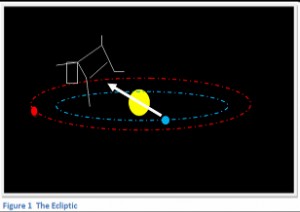 The Constellations: There are several constellations or grouping of stars in the sky that can be seen around the earth in all directions. Many of these grouping of stars correspond to the mythology of various regions of the world. Northern constellations can only be seen in the North because they are overhead.
The Constellations: There are several constellations or grouping of stars in the sky that can be seen around the earth in all directions. Many of these grouping of stars correspond to the mythology of various regions of the world. Northern constellations can only be seen in the North because they are overhead.
People in Australia cannot see these constellations because they would have to be able to see through the ground which they stand on and likewise with the southern constellations for the people of the north. This brings us to the constellations of the zodiacal signs. The stars of the zodiac are located on the Ecliptic which is the plane on which all the planets rotate around the Sun. In the illustration below one can see two planets rotating the Sun and if the blue planet represents the Earth then Sun will appear to be in the constellation of Taurus, a constellation on the ecliptic, to the observer on the Earth.
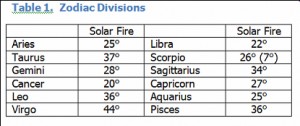 It should be also noted that there are only 12 constellations which circumscribe the ecliptic. The ecliptic is the path the Sun and Moon follow in the sky. In most astrological systems, the 360° ecliptic is divided into 12 evenly divided zodiacal signs each of 30° (30° x 12= 360°). However, by examining the sky one will note that some of the constellations will actually overlap each other while others are larger or smaller than 30° which we assume them to be. Table 1 shows the magnitude of signs based on what Solarfire, an astrology program, gives as the signs.
It should be also noted that there are only 12 constellations which circumscribe the ecliptic. The ecliptic is the path the Sun and Moon follow in the sky. In most astrological systems, the 360° ecliptic is divided into 12 evenly divided zodiacal signs each of 30° (30° x 12= 360°). However, by examining the sky one will note that some of the constellations will actually overlap each other while others are larger or smaller than 30° which we assume them to be. Table 1 shows the magnitude of signs based on what Solarfire, an astrology program, gives as the signs.
The “13th Sign”
If you note that Scorpio, in Table 1 is listed as 26° and with 7° in parentheses. Between the sign of Libra and Sagittarius there are 2 modern constellations which contact the ecliptic. One is the constellation of Scorpio and the other is Ophiuchus, the serpent bearer and is classically depicted by a man holding a serpent. Over the centuries this area has been designated the 8th sign in astrology and is currently called Scorpio.
The number 8 is a number which esoterically deals with regeneration which is an attribute of the astrological sign of Scorpio. The originally the constellation of Libra was a larger constellation as it had once owned the claws of the current scorpion and the eighth sign consisted of only Ophiuchus, the serpent bearer. The serpent makes sense for the sign of regeneration because a snake will shed its skin, symbolically representing death and rebirth and thus transformation.
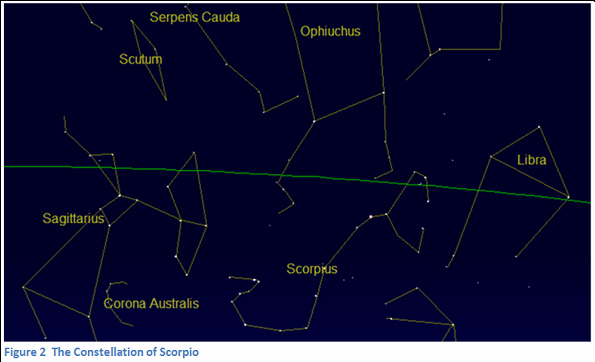 At some point, the ancients made some adjustments to the constellation and the scales of Libra became the claws of a new constellation of the Scorpion. The 8th sign was now configured to have the name Scorpio which was the first sign after Libra. Personally, I feel the snake of Ophiuchus is a better symbol for the 8th astrological sign than a scorpion. For the sake of you Scorpios reading this, I can imagine you would rather be about transformation rather than your poisonous sting. Nevertheless, the ancients have always chose to divide up the zodiac into 12 signs and which have been used for at least 2500 years in both the western tropical astrology as well as in eastern sidereal astrology. Many Vedic astrologers claim their astrology to be 4000 years old still and never were there more than 12 signs. It should also be noted the sign of Scorpio went from being a snake to an eagle and then a scorpion.
At some point, the ancients made some adjustments to the constellation and the scales of Libra became the claws of a new constellation of the Scorpion. The 8th sign was now configured to have the name Scorpio which was the first sign after Libra. Personally, I feel the snake of Ophiuchus is a better symbol for the 8th astrological sign than a scorpion. For the sake of you Scorpios reading this, I can imagine you would rather be about transformation rather than your poisonous sting. Nevertheless, the ancients have always chose to divide up the zodiac into 12 signs and which have been used for at least 2500 years in both the western tropical astrology as well as in eastern sidereal astrology. Many Vedic astrologers claim their astrology to be 4000 years old still and never were there more than 12 signs. It should also be noted the sign of Scorpio went from being a snake to an eagle and then a scorpion.
It can be seen that if the 7° of the current Scorpio when back to the Libra, Libra would become 29° and the Serpent would be 19° just slightly smaller than current Libra (22°) and about the same size as Cancer (20°). However, once astrologers moved from an omen based system to a numeric system then the constellations were divided up in 30° equal segments which astronomers/astrologers followed and recorded the positions of the stars in books called ephemerides (plural) or ephemeris (singular). An ephemeris can tell you what the planetary positions are day by day.
Precession
In order to understand the difference between the Sidereal zodiac and the Tropical zodiac one must grasp the concept of the Precession of the Equinoxes.
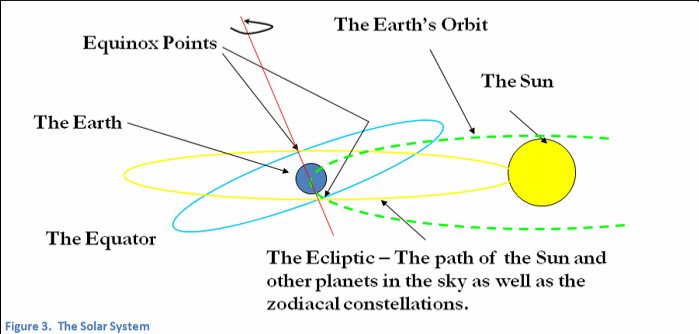 The Tilt of the Earth: the Earth is tilted relative to the Ecliptic by approximately 23.5°. This is why in winter and summer the North Pole and South Pole will experience the Midnight Sun and no Sun depending on the season. Figure 2 shows several aspects from the Earth’s orbit around the Sun to the Sun’s orbit around the Earth as well as the tilt of the Earth relative to the rotation around the sun.
The Tilt of the Earth: the Earth is tilted relative to the Ecliptic by approximately 23.5°. This is why in winter and summer the North Pole and South Pole will experience the Midnight Sun and no Sun depending on the season. Figure 2 shows several aspects from the Earth’s orbit around the Sun to the Sun’s orbit around the Earth as well as the tilt of the Earth relative to the rotation around the sun.
Solar Points: these are the equinoxes and the solstice points. The equinox happens twice a year, once at spring (approximately March 21) and once in the autumn (approximately September 23). The definition of the equinox can be one of the following:
- When the length of day is equal to the night
- When the Sun is directly over head at the equator and …
- When the Sun is at the point where the ecliptic crosses the equator.
The solstice happens twice a year as well. These occur once in the winter (approximately December 21) and in the summer (June 22). The definition of the Solstice is:
- When the Sun is at the highest/lowest point from the equator.
- Signifies the beginning of winter or summer depending on the hemisphere you are on.
Note: the seasons are reversed in the southern hemisphere.
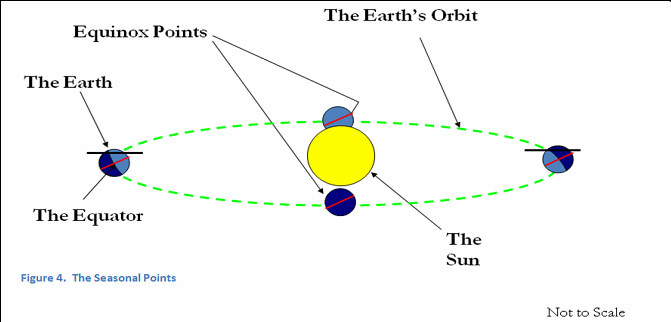
The Precession of the Equinoxes: this is the final point to understand. To the ancients, any light in the sky was a star. Comets were “hairy” stars. The lights of the constellations are referred to as fixed stars whereas planet is a word that means wandering star. The fixed stars were called fixed because they didn’t move relative to each other. They actually do move but it is at a very slow rate that we can barely notice the difference over the past couple of thousand years. The ancient astrologers, noticed that the constellations had started to move relative to seasonal placements. Where certain fixed stars were supposed to line up with Earthly objects on a given day of the year, the astrologers started to see that they would be “misaligned”.
One must keep in mind that in days gone by there were no computers or advanced calculating systems and that much of this information was passed down from teacher to student and were recorded empirically. The earliest recorded mention of the Precessional Cycle was attributed to the Greek astronomer Hipparchus, around 150 BCE, but it was probably noted well before him.
Early astrologers started to notice that instead of seeing that the spring equinox was in Taurus, like previous generations, it was in Aries and at the beginning of the Current Era that generation saw the spring equinox was moving back into the sign of Pisces. This is why it is called a Precession because it moves backwards through the zodiac as opposed to the planets and luminaries which move from Aries to Taurus to Gemini, which would be a progression.
The main factor has to do with the tilt of the vertical axis of the Earth. The Earth rotates around the Sun tilted on an angle (~23.5°) and direction of that tilt is changing as a result of the wobble of the Earth. If you could imagine yourself going about your business leaning to your right side and that slowly over the course of time you start tilting to your front so you are leaning forward and then after some more time you will be leaning to the left, then backwards and then your right side. The reason why this is important is that the equinox point is where the equator and the ecliptic meet. If you are leaning to the right, the ecliptic will meet your equator in front and behind you. Over the course of time if you are leaning forward then the ecliptic will meet your equator to the right and to left of you. See Figure 4.
Moreover, the Earth’s orbit around the Sun takes 365.2422 days. Even though we add a day to our calendar every four years (leap year) to bring it in check, the Earth hasn’t exactly made it back to the same spot of the zodiac on a given day, so the back drop changes. These two effects will effectively create the precessions of the equinoxes creating a “Great Year” which takes the equinoxes approximately 25,800 years to complete a full circle. On a smaller time scale, the effect this will have on the zodiac is that it will shift 1° every 71.67 years.
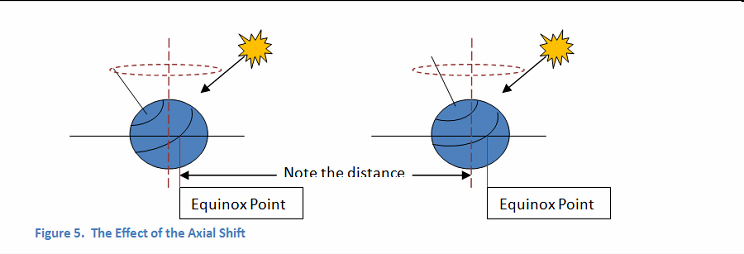
The Two Astrological Systems
The consensus is that the astrologers from about 2500 years ago were developing the zodiac system (12 signs) and they started to develop the degree system at the same time. It is believed the astrologers before them were generally performing more of an omen based system of astrology. Despite knowing of the precession of the equinoxes, the western astrologers started the Tropical system during the time when the Vernal Equinox was in the Sign of Aries which is why Aries starts with the Vernal Equinox. Although, the first ephemerides were discovered around this time they didn’t appear over night, so one must assume someone was making note of the planetary placements over the course of a few hundred years.
The Tropical System
The Tropical system is also known as the seasonal system. This system starts at spring at the exact time of the Vernal Equinox, which could happen any time between March 20th and March 21st. If you examine your astrological calendars, you will see that on one of these two days, the calendar will say the Sun enters Aries. In 2010, the Sun entered Aries on March 20 at 13:32 EDT, the time of the Equinox which is the first official day of spring in the northern hemisphere (and autumn in the summer hemisphere).
The first day of summer is marked by the summer Solstice and it occurs sometime between June 20th and 21st. This also marks the Sun’s entry into the sign of Cancer. The first day of autumn is usually on September 22 or 23rd which coincides with the Sun’s entry into Libra and December 20 or 21st is the first day of winter coinciding with the Sun’s entry into Capricorn.
The other signs between the cardinal points are divided into equal sections to fill in the rest of the zodiac.
The Sidereal System
The Sidereal system follows the actual constellations more closely than the Tropical system although the Sidereal system still assumes the signs are all 30° which they are not. However, you do stand a better chance of being correct when seeing a planet in the sky and stating what sign it is. For example, if you saw Saturn in the sky in November 2010, it had the sign of Virgo as the back drop as in the Sidereal system and not in Libra as you would with the Tropical system.
What’s the difference? Right now at this time there is a difference of 26° between the two systems. So if you were to say the Sun is 15° of Sagittarius in the Tropical system, the Sun would be at 19° of Scorpio in the Sidereal system. The difference between them will be 1° greater every 71.6 years and in about 10900 years when the Sun is in Aries (Spring Equinox) the Sun will actually be in Libra.
The two systems were the same (0° Aries = 0° Aries) in 285 C.E. by the Lahiri Sidereal system which sets the zodiac based on the position of the fixed star Spica. In India, the Lahiri system is one of the 2 government sanctioned systems.
How Do Both Systems work?
I have used 12 signs in my astrology and it works quite nicely as has my teacher for over thirty years of professional consultations and like the astrologers before us have used for thousands of years. So, it is decided we will continue to work with 12 signs. What remains to be examined is the shift in the zodiac, the precessed chart (sidereal) versus the fixed seasonal chart (tropical) despite the adamant objections from tropical astrology Leo’s who do not want to become sidereal Cancers.
In my own chart my sun sign doesn’t change because I was born when the Sun was at the end of the sign of Aries. I would have been born a Taurus if my mom was in labour for 5 more hours. My Moon sign changes in the Vedic system as does my Rising Sign (Ascendant) and as do most of my planets but the astrological interpretations end up being similar as far as my personality goes. This does seem odd that you could still have a similar reading with all the changes in the chart but what doesn’t change is the inter-relationship of the planets within the chart. My Mars squares or is 90° from my Mercury in both systems. If you move my Mars by 24° due by precession, Mercury also moves the same amount such that relationship between the two planets does not change. Imagine you have a house which faces north with your bedroom at the front of the house and the house has a back door. Now, pick up your north facing house and rotate it 26°. It will now face north by north East but your bedroom would still be in at the front, the back door is still at the back.
The other consideration is that planets rule the astrological signs Mars rules Aries and Scorpio, Venus rules Taurus and Libra, etc. The signs are placed on the cusps of houses. Astrological houses rule different facets of life from mind to parents to health and children to name a few. Both systems give the same results because of the interaction of the planets and the houses which they rule over. Nevertheless, if you go for a reading with a western (Tropical) astrologer and an eastern (Vedic) astrologer you would get pretty much the same information from how you act to your relationship with parents, spouses and to your career path. I have personally tried this and have also read books and articles and taken classes in both systems although I prefer to work with the Tropical system.
I want to state that I have nothing against science, as I am an engineer, but this “New Zodiac” sounds like a scientist or skeptic messing around with people. As a scientist but I realise there are differences between physics and language, chemistry and music. Science cannot measure love or why you like electro-dance music which brings me to the final point in why both Sidereal and Tropical astrology can work and why the signs do not have to line up with the actual zodiacal constellations.
Although astrology uses science to determine orbits and positions, astrology is not a science…it is a language!! It is a language that helps you understand yourself and the various cycles which you will go through in the course of your life time. That’s why when we astrologers hear someone say they don’t believe in astrology, we tell them that we don’t believe in Spanish.
In closing, I would like to conclude the zodiac did not shift as that shift was used by a different branch of astrology and that there is no new sign but rather an older version of the current sign and that the 12 currents signs work quite well. The best way to prove that astrology works is not to read your horoscope, although it’s fun, or read silly articles on the web but to have a consultation with a reputable astrologer and judge for yourself. They will need your date of birth, place and exact time of birth. You’ll find that they use 12 equal signs. However, the Mayans have a totally different calendar with 19 signs but that’s a story for another time……
Book your Astrological Reading
